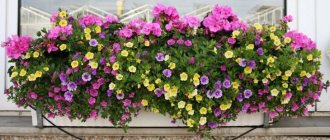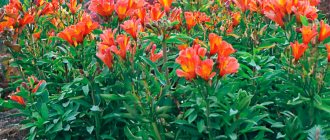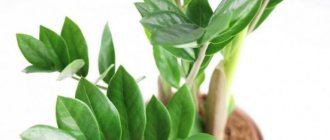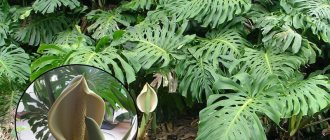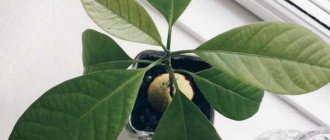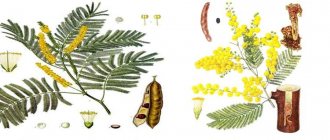Nematanthus is a unique plant native to South America. The crop belongs to the Gesneriaceae family, which grows in the wild. There is a wide variety of species, which range from epiphytic lianas to shrubs.
Nemanthus and hypocyrta were previously considered different plants, but now they are classified as the same species. The name Nemanthus was given by the German scientist Heinrich Adolf von Schröder, combining two Greek words: nema - “thread” and tantus - “flower”.
And the name Hypocyrta was given by the famous botanist Martius. It also consists of two Greek words, which in translation mean “under” and “curved.” This is how you can describe the appearance of this flower, which grows by bending its shoots downwards.
In this article we will look at the main types of hypocyrta, proper care at home, and photos of the plant.
External characteristics
The leaves are elliptical in shape with a pointed tip. Subspecies with significant bending of the plate are often found. Its surface, depending on the variety, can have either a glossy finish or soft fluff. The back side often has a purple tint.
A yellow or orange flower appears from a bud, which is tied on the stem part of the plant at the base of the leaves. Formation begins in the summer. The bud has a tubular structure, resembling the outline of an inverted pipe, with a widening at the base.
Interesting! Among the many species, there are evenly standing specimens reaching 60 cm in height. Hypocyrtus vines with shoots about 15 cm long are also found.
Why the flowering period does not occur: main problems
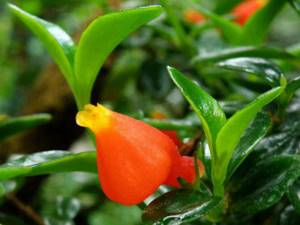
Many gardeners are faced with a situation where nematanthus does not bloom. Most often this happens due to improper care of the plant. To ensure that the flower always looks great and delights you with its exoticism, it is not recommended to use pots that are too large. In addition, it is necessary to provide the nematanthus with bright lighting, regular watering, optimal temperature and humidity levels in the room, and also use fertilizer for indoor flowers in accordance with the recommendations given earlier. And do not forget to prepare the flower for winter, since rest at this time of year is vital for it.
Main varieties
Hypocyrta glabra
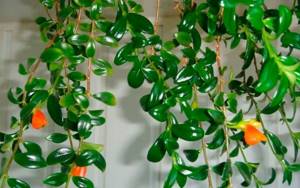
It grows naturally in Brazil. This is a shrub that develops as an epiphyte on other crops. Hypocyrta naked can grow up to 25 cm. It has a slightly branched stem part.
This is an evergreen plant with short, glossy, dark-colored leaves. Their maximum length is 3 cm, and their width is half that. The flowers are located in small inflorescences and have a bright orange pigment.
The petals of the corolla grow together with a tube-like spherical process of the flower, which has a deflection.
Nematanthus nummularia
Compared to the previous species, it has miniature parameters, which it achieves in the process of development. Grows in Guatemala and Costa Rica. It is also an epiphytic form, liana-like with a small number of branches.
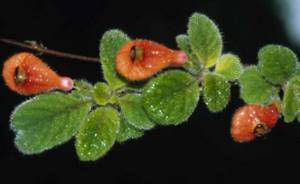
The leaves are light green, rounded and ovoid in shape. They have a fleshy structure and do not grow more than 2 cm in length. The stem, like the leaf, has a fleecy covering.
The color of the main part of the bud is a rich red hue. It has a light yellow limb from the main shape of the flower, which becomes black at the base of the pharynx.
A peculiarity of this variety is its ability to shed leaves along the entire length of the stem part at the end of the flowering period.
Nematanthus gregarius
This is a mini plant that has compact dimensions. The habitat of this climbing species is Brazilian forests. Due to the rich yellow-orange color of the flowers and the similar shape of the bud, it received the second name “goldfish”. The leaf is glossy and small. On the inside, the color varies from burgundy to purple.
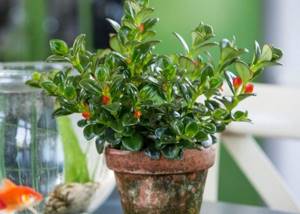
The shoots are straight at first. Later, due to excessive juiciness, they sag and a general downward tilt of the entire plant is created. This form allows gardeners to actively grow this hypocyrta in flowerpots and other types of hanging flowerpots.
The peduncle is short, the petals grow together on the inside of the bud. Inflorescences can reach up to 5 centimeters in length. The flowers have a waxy coating. They can be pink or purple. Flowering does not stop from early spring until the end of autumn.
Nematanthus fluminensis
It is distinguished by a light lemon color of the flower. The liana, supported by supporting supports, can curl in any direction. The leaf is large with a glossy surface. Can reach 10 cm. Arranged in pairs. On the inside it takes on a reddish tint.
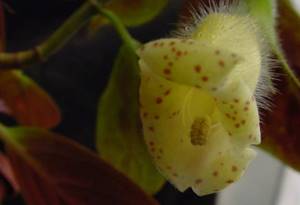
There can be no more than three buds in an inflorescence. The opened flower resembles a funnel in shape, which has a bulge on one side. Flowering occurs from April to October.
Nematanthus fritchii
In the wild it can grow up to 60 cm tall. It also has large leaves that reach 8 cm in length. Thin shoots significantly descend downward during growth.

The flower is fluffy, bright pink, funnel-shaped. There is also a paler muted color. The size of a mature bud is about 5 cm.
Nematanthus longipes
This is a broad-leaved liana-like shrub of light green color. The leaf surface is soft, arranged in pairs. The length of the plates reaches 10 cm.
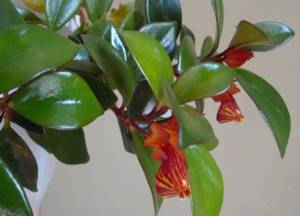
The flowers are solitary, funnel-shaped, of the same size. Color coral red. There may be several peduncles emerging from one axil.
Nematanthus wettsteinii
A shrub with shoots arranged in an erect form. Their length reaches 90 cm. The plant branches well, which allows it to be grown as a hanging crop. The leaves are small with a waxy surface.
Flowers are red-orange or yellow-orange up to 3 cm in length. Their shape is tubular with a slight lateral convexity. With good care, the plant blooms for a long time.
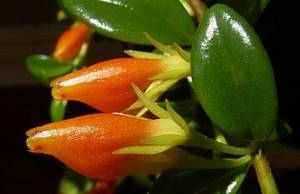
Nematanthus species
- Nematanthus anklet is a subshrub with oval smooth leaves up to 10 cm long and red flowers.
- Nematanthus Wetsteina is a plant with thin hanging stems maximum 90 cm long. The leaves are small, waxy, and have a beautiful dark green color. Blooms with yellow-orange flowers.
- Nematanthus Tropicana has yellow-orange flowers with red stripes.
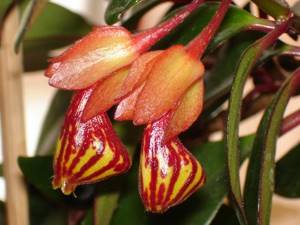
Nematanthus Tropicana flower
- Nematanthus Gregarius - It is thanks to this species that Nematanthus is sometimes called a goldfish. Its yellow-red flowers really resemble aquarium fish in shape and color.
- Nematanthus Prirechny is a climbing plant with lemon flowers. The leaves are shiny, green above, reddish below, smooth and shiny, 5-10 cm in size.
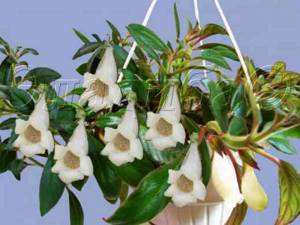
Nematanthus riverine
- Nematanthus Fritsch is a shrub up to 60 cm high with a pubescent stem and pink flowers. The leaves, colored red on the underside, reach 7.5 cm.

Flowers and pubescent leaves of Nematanthus Fritsch
- Nematanthus naked is a semi-ampelous shrub with glossy small leaves and bright orange flowers.
- Nematanthus Monetolifolia is a plant with drooping shoots and tiny light green leaves. When the red flowers with a yellow edge fade, the plant sheds its leaves.
- Nematanthus Fine-bristle is a miniature plant, no more than 25 cm in height, with orange-red flowers.
Home care
After acquisition, the hypocyrta should be pruned. This involves removing a third of all shoots. This way you can lay out the future shape of the plant and add branching. Which will lead to abundant flowering, since peduncles form on young shoots.
Watering
Irrigation of the plant varies depending on the time of year. The spring-autumn period involves moderate moisture. In winter - less than usual, but do not allow the soil to dry out too much.
Important! With the arrival of hot weather, you need to water abundantly. The hypocyrtus flower does not tolerate irrigation with cold water. Warm it up first or at least let it reach room temperature.
Landing
You can select a substrate for hypocyrta in the store. In this case, it is worth purchasing soil for violets. It’s also easy to make your own substrate. For preparation you will need equal shares of sand, peat, humus and soil for leaf crops.

Transfer
This procedure needs to be carried out only once every 2-3 years. Hypocyrta is a slow growing plant. Therefore, there will simply be no need for frequent transshipment and changing the flowerpot to a larger size. Its volume must exactly correspond to the size of the plant’s root system.
Important! When planting, be sure to use drainage. Don't forget about the holes for excess liquid. Otherwise the root will rot.
It is necessary to take into account and always maintain high air humidity in the room where the hypocyrt is located. When growing in an ampelous form, it is necessary to regularly spray the crop. If it is a bush, there must be a tray with wet pebbles or sphagnum under the flowerpot.
The video below explains how to properly care for Nematanthus.
Temperature
The thermometer readings, like watering, should be adjusted depending on the season. The main conditions are the absence of drafts at the location of the hypocyrt and sudden changes in temperature.
A comfortable summer thermometer reading should be +20°C, acceptable +25°C. In winter, a decrease to +16°C is possible. Only hypocyrta naked can withstand an additional decrease of another 2 degrees.

Lighting
Hypocyrta is a light-loving plant. But despite this, it does not tolerate direct sunlight on the crown. In the summer, they can simply burn the leaves. In winter you will need additional lighting.
Advice! As additional lighting, you can use regular table lamps.
Microclimate
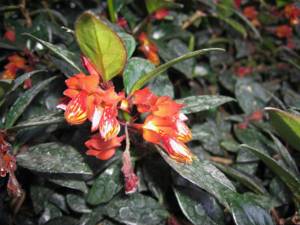
If the room temperature is 28 degrees or higher, the flower will suffer. Therefore, at night it is better to take it outside or into a cooler room with an air temperature difference of approximately ten degrees. This is necessary so that Nematanthus can rest from the heat of the day and gain strength. The plant tolerates short-term cold snaps quite normally, but it is not recommended to keep it for a long time at temperatures below 12 degrees, since otherwise the nematanthus will lose its attractive appearance. And at a temperature of 5 degrees, the leaves of the flower may fall off. When caring for this plant, much attention should be paid to indoor air humidity. Nematanthus (goldfish is one of its names)_ grows best with a humidity of at least 50 percent. But the ambient temperature plays a big role here. The higher it is, the higher the humidity should be. To do this, it is necessary to spray the plants with water from a spray bottle. But this must be done in such a way that water does not get on the flower itself, otherwise it will lose its decorative effect. A good alternative to spraying is to place a container with wet pebbles near the plant. In winter, spraying is not required, since due to low temperatures the flower may freeze and die.
Nematanthus: folk superstitions, benefits and harm
Hypocyrta is a unique flower that many housewives prefer to see in their homes. It is believed that if this plant is placed in a residential area, it will bring good luck to its owner.

It should be noted that nematanthus contains substances that are capable of purifying the air from various impurities. According to studies, the positive impact of culture on the human body has been proven. If you spend a long time in the room where the flower grows, you can notice a significant improvement in your general condition. Nematanthus also relieves stress and restores the functioning of the nervous system.
Preparing nematanthus for wintering
In order for the plant to overwinter well, it is very important to provide it with suitable conditions. The plant should be placed in a place with good lighting that is away from the heating system. In addition, for the winter period the amount of watering should be reduced and fertilizing should be stopped altogether. If the room temperature does not exceed 12 degrees, then you don’t have to water the flower at all.
If the nematanthus is kept in a warm room throughout the winter, its flowering period will not be as abundant or will not occur at all. Therefore, it is recommended to place the plant in a cool room for at least 8 weeks.
Pests and diseases
If the plant is kept warm in winter, aphids can settle on it. The best placement option to avoid this situation would be a cool and well-lit place.
All diseases of this plant are certainly associated with improper care:
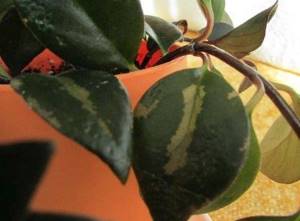
- Excessive moisture and cold will cause the leaves to drop.
- With prolonged sun exposure in summer, low humidity or oversaturation with fertilizers, the foliage fades and turns yellow.
- Leaf curling and yellowing appear when there is too much light. In this case, it is worth moving the plant to partial shade.
- Irregular watering or the use of too cold water will result in the appearance of brown pigment on the leaf.
- A gray coating on flowers or leaves signals the appearance of powdery mildew. You should immediately stop spraying with water. Eliminate the affected areas and treat the remaining parts of the crop with a fungicide.
- With a lack of lighting, humidity, heat, lack of nutrient medium, fertilizers, flowering will most likely be completely absent or occur in a meager form.
To avoid this, it is necessary to exclude all factors influencing the formation of peduncles and not to forget about partial spring pruning of the stems.
Growing problems, diseases and pests
Like many tropical flowers, the main problem of Hypocyrta variegata and its relatives is a violation of the temperature, light and humidity conditions:
- Lack of moisture - the shoots dry out.
- Excess moisture - the plant rots.
- Excess moisture with a lack of heat means falling leaves and buds.
- Lack of light - the leaves darken, flowers do not form.
- Excess light - leaves turn yellow, brown spots appear (burn).
- Excess light with abundant humidity - brownish-brown leaves.
- Lack of heat - flowers do not form, leaves dry out.
The plant is susceptible to parasites - aphids, scale insects, spider mites and whiteflies. Insecticidal preparations help against parasites. You can use folk remedies, for example, a soda solution, but they are less effective. To avoid problems with improper flower growth, you need to follow the watering and fertilizing regime, monitor the light and temperature.

Sick plant
The capricious but beautiful tropical flower nematanthus will please the eye with proper care. It is suitable for flower growers with at least a little experience. For beginners, this plant can be challenging.
Reproduction of hypocyrta
It is best to grow a new plant from cuttings. The separated shoot must contain 4 or 5 internodes. After removing the lower leaves from the cutting, you need to place it in water or sand for the root to appear. During this period, care involves greenhouse conditions with temperatures from +22°C to +24°C and periodic ventilation.
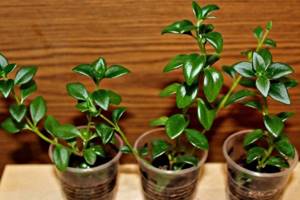
Next, planting is done in a permanent place of growth. To form a beautiful and stable crown of the fluffy hypocyrta subspecies, it is worth planting several cuttings in one flowerpot. Glossy varieties also look beautiful in cases of single cuttings being planted due to the large branching of the crop. You can help in the formation of the desired crown by periodically trimming the upper internode.
As for propagation by seeds, this should be done in early spring. Well-dried grains are sown in a nutrient substrate and covered with glass or polyethylene on top.
Important! When propagated by seeds, the first flowering can be observed the next year.
Seeds should only be watered through a tray. After the first shoots appear, the mini-greenhouse can be removed. After three to four weeks, a dive is carried out. Several specimens should be planted in each flowerpot.
By observing all planting and growing conditions, you can get a beautiful and healthy plant that will delight you with its abundant flowering for a long time.
Propagation of nematanthus by cuttings

Nematanthus cuttings photo
Rooting of cuttings is carried out in spring and summer. Cut the apical or stem cutting 7-10 cm long. The lower cut should pass under the node, also remove the two lower pairs of leaves. You can root in peat soil, sphagnum moss or water.
To root in the substrate, you need to cover the cuttings with a cap made from a cut plastic bottle or a plastic cup and maintain a temperature of 22-24 ° C. Rooting occurs after 2-3 weeks.
Next, young plants are planted several at a time in one container with drainage and suitable soil (as for replanting adult plants).
Diseases and pests
Nematanthus is highly resistant to various diseases and harmful insects, but this does not mean that the plant does not need any protection. Very often, the flower infects plant mites, aphids, bladder-footed and hairy lice.
Hair lice are very difficult to detect because they live in the axils of leaves. The damage to a flower by these pests can be recognized by white formations resembling cotton wool. Insects are removed manually using a swab soaked in alcohol.
To combat all other harmful insects, insectoacaricides are used. You should not delay this, since pests, sucking the juice from the plant, can cause the development of various viral diseases of Nematanthus; the reason for the falling of leaves may also be this.
If the flower is kept in a hot room that is poorly ventilated, then Nematanthus can be affected by fungi. With proper maintenance and care, the likelihood of this happening is extremely low, but if this suddenly happens, the flower is treated with fungicides.
The most common problems that gardeners encounter when breeding nematanthus are:
- drying of the tops of the leaves: occurs due to keeping the flower in an incorrect microclimate;
- leaf fall: can occur due to improper watering or a strong change in ambient temperature;
- leaves become brown or covered in spots: this occurs due to watering with too cold water.
If you follow all agricultural technologies, you will never have any problems with this plant.
Planting and care

Nematanthus are not replanted immediately after purchase. For a young plant, the procedure is performed approximately once a year, and for an adult - as the free space in the pot decreases. The right time for this is spring. The plant does not have a large root, so it does not need a large pot. The new container should be 2 cm larger in diameter than the previous one. Nematanthus growing in pots that are too large often get sick, develop poorly and do not bloom.
The transplant process goes like this:
- A third of the pot is filled with expanded clay. It plays the role of drainage and prevents rotting.
- Carefully remove the top layer of soil in the old pot, being careful not to injure the roots.
- The plant is removed without destroying the earthen lump.
- The nematanthus is placed on a drainage layer in a new container.
- The voids are filled. A mixture of leaf soil, peat, humus and sand is used as a substrate (the ingredients are mixed in a ratio of 2:1:1:1).
- The soil is not compacted. Finally, the planting is watered.
In order for the nematanthus to be as beautiful as in the photo, care at home must be approached responsibly. This is a light-loving plant. In order for it to develop properly, it needs bright, diffused lighting. The optimal daylight hours are 13 hours. The plant feels comfortable on eastern and western windowsills. Nematanthus can also be placed near a western window, but in this case in winter it will experience a lack of light. This will negatively affect flowering. To solve this problem, hang phytolamps. When placing a flower on a south-facing window sill, it is important to provide shading at lunchtime in the summer. If this is not done, burns will appear on the leaves.
Suitable air temperature for nematanthus is +20-24 °C. If this indicator is maintained at +13 °C and below for a long time, this will negatively affect the appearance of the plant. When the temperature drops to +7°C, the green mass turns brown and crumbles. Excessive heat also negatively affects nematanthus. At a temperature of +27 °C or more, the process of its development is disrupted. The flower is positively affected by a nighttime decrease in temperature by +5-8°C.
Attention!
It has been scientifically proven that nematanthus cleanses the air of harmful impurities. It relieves stress, improves the functioning of the central nervous system and has a beneficial effect on the entire body.
Water the plant as soon as the top layer of soil begins to dry out. Excessive moisture leads to rotting, and drying out leads to leaf drop and loss of the ability to bloom. Soft, settled water is used to moisten the soil. Large-leaved specimens consume more liquid, and small-leaved specimens use less. The plant requires a humidity level of 55%.
In summer, spray regularly, taking care not to wet the inflorescences. The warmer the air, the more often the procedure is repeated. Nematanthus should not be placed near heating devices. During the period of active growth, the flower is fed once every 2 weeks. For this purpose, complex mineral preparations are used. In autumn, fertilizing is applied once a month.
Description and varieties
Nematanthus includes many species, from epiphytes to subshrubs. Among them there are climbing, hanging and vertically growing varieties. Some of them can bloom beautifully. All species have small, succulent-like leaves that are elliptical or oval in shape. They are covered with a thick cuticle. The color of the leaves can be both light and dark. Some species have a purple tint on the lower part of the leaf blades.
Most varieties have smooth, glossy leaves, but there are also varieties with a velvety surface. Flowering varieties are of great interest to amateur gardeners. Scarlet, red, pink and purple tubular flowers are a spectacular decoration of these plants. If you compare Nematanthus with different photos of other indoor flowers, you will notice that it wins in many respects.
The most famous varieties:
- Coin-leaved. This is a climbing plant with round pale green leaves about 2 cm in diameter. The flowers are scarlet with yellow stripes. After flowering ends, the green mass falls off.
- Fritcha. It looks like a bush, about 60 cm high. Its thin, pubescent shoots bend under the weight of the flowers. The latter have a funnel-shaped appearance and contain pink pigment.
- Naked. This is a climbing variety with thick elliptical leaves about 4 cm long. The flowers are small and red.
- Long-legged. It is a subshrub. It has bright green elliptical leaves up to 10 cm long. The flowers are scarlet. They are located singly along the shoots.
- Gregarius. Flowers of this variety have a blown barrel. Thanks to this feature, it is also called a goldfish. The leaves are small, dark green.
- Wetstein. This is a climbing variety with graceful flexible shoots up to 1 m long. The leaves are small, oval-shaped, deep green. The flowers are small, orange in color. It is distinguished by lush flowering.
- Tropical. It is an exotic plant with oval leaves, pointed at the end. The flowers are yellow-red.
Attention!
Under natural conditions, flowering of nematanthus occurs exclusively in summer. In home flower beds, this process continues from early spring until winter.
During the period of growing nematanthus, flower growers saw some cause-and-effect relationships and derived signs. It is believed that if you carefully care for the plant, it will attract happiness, positive mood and wealth to your home. The one who saw the first blossoming bud will soon have his most cherished wish come true. The more abundantly the plant blooms, the more favorable fate is to the owners of the house.
